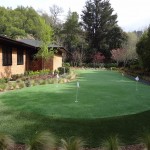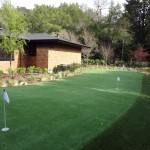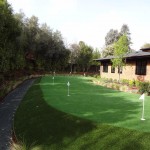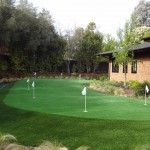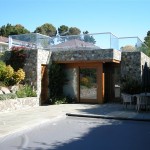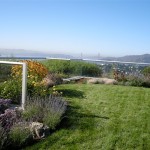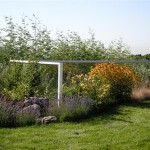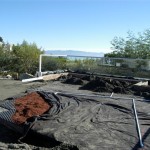This large synthetic turf putting green for a project in Kentfield featured two distinct tiers and varied hole locations to create a visually interesting and challenging green.
One of the keys for creating a more interesting green is soften the edges with plantings and create a varied fringe area, so that the green is not just bordered by a uniform fringe.
We worked with Jim Bradanini and Associates for the design and placement of the green and 1st Impressions Greens for the installation.
Category Archives: Sustainable Landscapes
Handling Storm Water Storage
With storm water regulations getting more and more strict, keeping drainage and storm water on-site has become more and more important. The best way to handle storm water on a site is grade the side to maximize natural infiltration into the soil.
Sometimes a site is too small, or the grades are too restrictive to allow for infiltration without some assistance. Typically this is done with a dry well. But the traditional dry well has its limitations. A dry well (dispersion field, dissipater field) is an excavated area constructed to allow for the infiltration of water, typically filled with 3/4″ crushed gravel. The main problem with dry wells is that half the volume of the well is filled with gravel, thereby limiting the amount of water that can enter the system and infiltrate into the soil. Take this example:
If you have a dry well that is 8′ long x 4′ wide x 2′ deep filled with gravel its capacity is only about 240 gallons of water at any one time. Let’s say you were trying to drain a 1,000 sq.ft. roof into the dry well. In a 1″ storm the roof would discharge about 550 gallons of water.
Fortunately, with the increased focus on stormwater management, there are some newer products that help with this problem.
Cudo Cube, based out of Sonoma County, offers a great customizable modular product that is 2’x2’x2′ and can store about 50 gallons of water as well. The Cudo system can also be customized for maintenance access, discharge point, and filtration. The units can be combined to create large drainage fields.
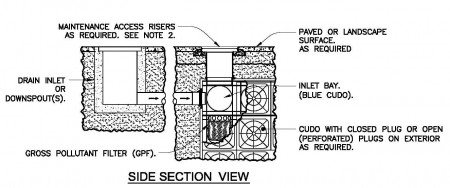
NDS has a couple of products that allow for easier drainage installations. The Flo-Well is a customizable plastic drum that holds about 50 gallons of water and can be plumbed into a drainage system or off a downspout. These units can also be connected together.
NDS also makes the new EZFlow french drainage pipe, that incorporates a traditional black corrugated pipe with a synthetic drainage medium that looks like a packing peanut. A 10″ EZFlow (4″ pipe with 6″ of drainage peanuts) can store about 2 gallons of water per linear foot.
ADS also has a number of products designed for stormwater and leachfields on a larger scale. Their AdvanEdge product is another useful alternative to French drains to help drain against retaining walls, into dry fields or under wet areas.
An Alternative to Grout
In the past few years there have been interesting developments in alternatives to grout and traditional joint fillers for flagstone and paver installations.
Ecosystems Grout sells a Eurogrout product that claims to allow water to permeate through the surface of the material, making it great for permeable pavement installations where rainwater is captured below the pavement, rather than redirected into a traditional drainage system.
These grout alternatives can also give a low maintenance more rustic appearance to an installation than traditional grout.
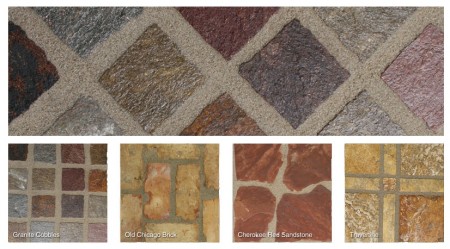
For more:
Visit the Ecosystems Website
From the Drawing Board: Penngrove Medditeranean Garden
This project in Penngrove had a front landscape that had served its purpose. The design solution integrated a path and seating area, while pulling out the old lawn. A water feature tucked into one corner serves as a focal point along the way.
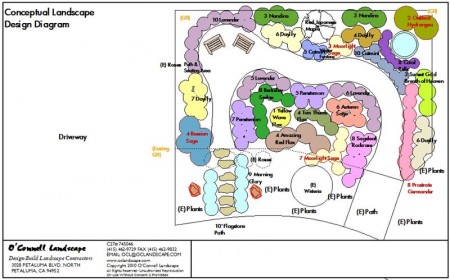
Bay Friendly- Apologizing to the Bay!
After attending a recent Marin County Bay Friendly Landscaper training session, I was so thoroughly impressed with the curriculum of the Bay Friendly Program and the quality of the speakers for the training session. The Bay Friendly Landscape guidelines form a compelling framework for sustainable landscape construction and maintenance. The one area where the training could be enhanced is with a greater emphasis on the history of the Bay and why Bay Friendly efforts are so important. For anyone who hasn’t seen the 4 part documentary “Saving the Bay,” which aired on KQED, it is an indispensible primer for the ecological, cultural, and social history of the San Francisco Bay. With this in mind, here is one landscaper’s Open Letter to the San Francisco Bay–
Dear Bay,
First off, we would just like to say we are sorry. Sorry for what we did to your forests and your streams. Sorry to the Grizzly, the Prong Horned Antelope, and the rest of your creatures that roamed long ago. Sorry to Salmon, that we canned by the bargeful. Sorry to the soil, that continues to slip away- only to wait another 10,000 years to form. Sorry to the great San Francisco Bay, estuary of estuaries, harbor of harbors.
We are sorry for the Baylands we filled, the marshes we drained, the streams and rivers we dammed and damned. Sorry for the pollution, the dumps, the garbage, the sewage. Sorry for our brake pads, that with every morning drive hit the road, and from the road flow to the Bay.
We say that we have changed. We say that we will be your friend, or at least that we will be Friendly. You have the benefit of time and experience. You wait with a watchful eye, marking the tides of moon and man.
Before we start on our new way, before we change our ways, let us acknowledge what we and our forefathers have done. See and acknowledge our mistakes, understand what we did wrong. Say we are sorry. Then we can embark on a better way.
After attending a recent Marin County Bay Friendly Landscaper training session, I was so thoroughly impressed with the curriculum of the Bay Friendly Program and the quality of the speakers. The Bay Friendly Landscape guidelines form a compelling framework for sustainable landscape construction and maintenance. The one area where the training could be enhanced is with a greater emphasis on the history of the Bay and why Bay Friendly efforts are so important. For anyone who hasn’t seen the 4 part documentary “Saving the Bay,” which aired on KQED, it is an indispensible primer for the ecological, cultural, and social history of the San Francisco Bay. With this in mind, here is one landscaper’s Open Letter to the San Francisco Bay–
Dear Bay,
First off, we would just like to say we are sorry. Sorry for what we did to your forests and your streams. Sorry to the Grizzly, the Prong Horned Antelope, and the rest of your creatures that roamed long ago. Sorry to Salmon, that we canned by the bargeful. Sorry to the soil, that continues to slip away- only to wait another 10,000 years to form. Sorry to the great San Francisco Bay, estuary of estuaries, harbor of harbors.
Sorry to the Baylands we filled, the marshes we drained, the streams and rivers we dammed and damned. Sorry for the pollution, the dumps, the garbage, the sewage. Sorry for our brake pads, that with every morning drive hit the road, and from the road flow to the Bay.
We say that we have changed. We say that we will be your friend, or at least that we will be Friendly. You have the benefit of time and experience. You wait with a watchful eye, marking the tides of moon and man.
Before we start on our new way, before we change our ways, let us acknowledge what we and our forefathers have done. See and acknowledge our mistakes, understand what we did wrong. Say we are sorry. Then we can embark on a better way.
More on Living Roofs
There was another green roof article in this month’s NorthBay Biz, Up on the Roof, profiling the rooftop installation at the Academy of Sciences in San Francisco and a couple of projects in the North Bay that is worth a look.
After our earlier profile of the Watershapes article of the same name, a new rule for all those green industry columnists, you must title your articles something other than Up on the Roof.
The Benefits of Green Roofs
For all those homeowners considering garden roofs, this rapidly developing specialty of landscape construction offers many sustainable benefits beyond just the wow factor of directly integrating garden spaces into residential architecture. The reduction in many of the ongoing heating, cooling, and insulation costs can help pay for the added cost of a green roof installation.
There was a great article in this month’s Watershapes Magazine on roof gardens. It’s a good primer and background on green roof types and the additional insulation and HVAC benefits to the insulation green roofs provide. (Catch it before the end of this month with the free on-line version)
Below is a gallery of a recent roof garden in Tiburon. We worked with Caletti Jungsten Construction and Pedersen Landscape Architecture to create a green roof for this unqiue pool house. See more in our Garden with a View Portfolio.
A More Sustainable Thanksgiving
For more and more landscape projects a key consideration is the hot topic of sustainable best practices, environmental impact, and how best to green projects.
This drive to green everything from carpets to cars isn’t unique to the landscape industry, its one of the major driving forces in both new marketing campaigns and genuine efforts to reduce and mitigate environmental impacts.
As I attended a workshop and last month’s North Coast dinner meeting by Trathan Heckman of Daily Acts here in Petaluma, it became clear to me that this idea of sustainability is really all encompassing. Trathan’s work and presentations on gray water systems, local agriculture, and community and back yard gardens brought this home. Our choices make a difference- from the decisions we make on things like irrigation and plantings, to what we eat and where it’s grown.
As Thanksgiving approaches and we give thanks, we can also consider the sustainability of the meal itself. We can support local economies and local agriculture, and also sustainable agricultural practices. Consider instead of a typical mass produced supermarket turkey for example, an alternative Heritage Turkey, bred in a free range environment, with reduced environmental impacts (or for even less enviornmental impact, skip the turkey). Good Shepherd Poultry and a growing number of other small turkey farmers are working to re-introduce heritage birds and raise turkeys more sustainably.
Saving the Bay
If you haven’t had a chance to see the excellent four part documentary on KQED channel 9, Saving the Bay, it is a great history of the amazing natural feat of San Francisco Bay and it’s trials and tribulations. This program is a thought provoking piece for all residents of the Bay Area. The Bay and its history is also important to take into consideration when doing landscape projects, and how landscape work effects the Bay (water use, drainage, sediment run-off, herbicides, pesticides, and wildlife effects).



A Greener Lawn & Lawn Mower
As part of our new demonstration garden at our office here in Petaluma we installed a native turfgrass lawn with subsurface irrigation. This represents a leap forward in water efficiency and sustainability, but now the question is, how do we mow it?
We wanted a lawn mower that would be cost effective, and we just needed it for office use. Getting the administrators out to mow the front lawn is similar to the idea of the company CEO using the copy machine from time to time.
After searching on Amazon.com and with help of user reviews we settled on 24 volt battery powered mower by Earthwise. So far we have been impressed. Power is good, and the deck height accommodates the 2-6″ recommended mowing height for the Native Bentgrass lawn. Plus the mower requires no gas, and doesn’t have the polluting emissions of a small engine lawn mower. The only problem we found in our search was that some reviewers complained about the possibility of damaging the battery if left to charge too long.
While it wouldn’t work for a commercial application this seems like an ideal mower for a homeowner with a small to mid-size lawn.

Simple Graywater Systems for Landscapes
I attended a demonstration in Petaluma by Daily Acts, a Sonoma County non-profit, of their graywater system, which was the first permitted residential system in Sonoma County. The workshop was given by Trathen Heckman of Daily Acts and Brock Dolman of the Occidental Arts and Ecology Center Water Institute. Both have been involved with graywater legislation that it is making its way through the state legislature and regulations by Sonoma County.
The simplest graywater system is a laundry to landscape system, which recycles graywater from the washing machine out into the landscape.
This system is easy to install with a few simple parts including a 3 way diverter valve, vacuum breaker and 1″ distribution laterals out into the landscape. In Sonoma County it can all be done with a simple plumbing permit, and without the need for more elaborate design, permitting and plumbing of a more extensive graywater system.
For More:
The Daily Acts website has a wealth of resources on graywater and a host of other projects as does the OAEC Water Institute website.
Greywater Guerrillas– has great information, workshops and more
Oasisdesign.net– more graywater design information
Video on Trathen’s Graywater installation in Petaluma:
Sunset Magazine Article- Synthetic Turf
There is a good article and overview in this month’s Sunset Magazine about synthetic turf and the pros and cons of the material versus natural lawn and other alternatives.
The author’s experience in a xeriscaped garden with synthetic turf reveals something that more and more people are realizing, synthetic turf has come a long way from Astroturf:
Then we went to a party at the house of a landscape designer who watered, she said, for only eight minutes a week, and did her own gardening, with no mowing. This was real xeriscaping: She had succulents, and drought-tolerant trees, and pink-flowering cactus, and
Mexican beach pebbles ― and two stunning green rectangles of perfect lawn in the back. “The grass,” another guest whispered to me. “It’s not real.”“It’s not?” I asked. It looked gorgeously real.
“Touch it,” she said.
I did, and it was true: The grass was fake.
It wasn’t Astroturf, exactly, but long, smooth blades of grass that looked exactly like real grass but happened to be plastic. It had been laid down like a carpet, over prepared ground.
What we are seeing in the landscapes where we use synthetic turf is that it is a great hybrid material. It has the properties of both a hard and a soft surface, with the maintenance requirements more like a patio space that needs to be hosed down occasionally, with a feel and utility like a natural sod lawn. Yes there are trade offs with the material, but given the current water crisis in California synthetic turf makes more and more sense in a variety of applications.
Synthetic Lawns & Play Space Installations
We are just working on finishing up a couple of projects in San Rafael and Mill Valley that incorporate play friendly synthetic turf with play structures and basketball courts. The owners of both projects have small children and wanted to create a safe and low maintenance outdoor play space for their kids.
In Mill Valley we installed a synthetic lawn with a play structure surrounded by rubber mulch. The rubber mulch is one of the most absorbent materials for play structures, which worked well in the compact space of the play area and the play tower and slide and this project.
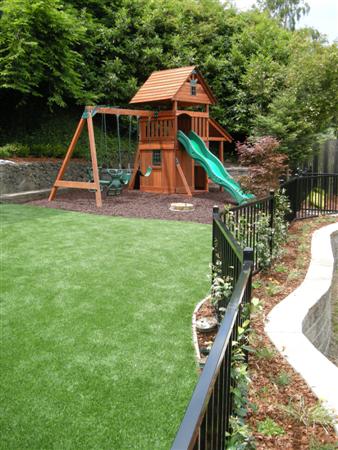 In San Rafael we installed a play grade synthetic turf with a premium mat backing for better fall absorption. The turf we used here was also denser and incorporated dead thatch yarn making it look much more realistic. We incorporated the lawn with a concrete patio and basketball court. The basketball court featured an adjustable hoop with tempered glass backboard that we installed.
In San Rafael we installed a play grade synthetic turf with a premium mat backing for better fall absorption. The turf we used here was also denser and incorporated dead thatch yarn making it look much more realistic. We incorporated the lawn with a concrete patio and basketball court. The basketball court featured an adjustable hoop with tempered glass backboard that we installed.
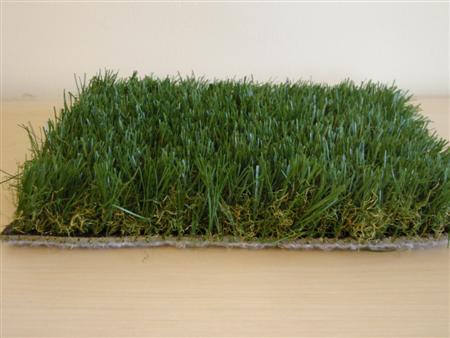
Bay Area Source for Rubber Mulch
Rubber mulch is gaining popularity in landscapes as an alternative material to woodchips for play areas and for landscape mulching. Rubber mulch has a higher absorption rate for playgrounds and a good life span when compared to wood mulch. There are some issues with the material, and its important to take into consideration the type of mulch being used. Not all mulches come from the same source and there are some concerns with toxicity of some recycled rubber products.
As with other alternatives like glass mulch, rubber mulch is going to cost 2-3x the cost of wood mulch, depending on the quantity installed.
The Cover Source, out of San Ramon is a good local reseller of rubber mulch that ships straight from the manufacturer is bulk quantites for landscape use.

Smart Controllers Made Easy- Hunter’s Solar Sync
I just had a meeting with our local rep from Hunter Irrigation. We use Hunter Controllers frequently on our projects. They have just launched a new smart controller module, Solar Sync, which adjusts programing for solar exposure, temperature, and rainfall. The multifunction sensor has a sensor for sunlight, can detect freezing temperatures, and turn the controller off in case of rain.
Unlike Hunter’s fancier ET system, the Solar Sync is cost effective and easy to program, with a simple module that adjusts the percent application of irrigation. Just program the controller for what normal watering would be during the hottest month of the year, make a few minor adjustments and the Solar Sync does the rest. Say it is 50 degrees on average during the month March, Solar Sync may only apply 10-20% of the normal maximum watering. The module recalculates the percent application each night, ensuring that plants are watered appropriately.
For more visit Hunter’s Solar Sync page

Heritage Salvage- Good resource for recycled materials
With the high cost of quality lumber and reduced availability of good wood materials for building, Heritage Salvage in Petaluma is an excellent resource for recycled and salvaged building materials. Not only is salvaged lumber a more environmentally friendly option for exterior wood installations like fences, often you can find unique material that has more character than newly milled lumber. The other advantage to using salvaged material is finding sizes and dimensions of lumber no longer available. Their website has a good overview of current stock, and their yard is definitely worth a visit.
Will salvaged lumber be cheaper than building your project with new material? It depends on the application and how much treatment and labor is required for the particular project. In many cases though, salvaged lumber makes good aesthetic, environmental and financial sense.

Save Water with Irrigation Upgrades
Concerned about possible water rationing in the near future, a client in Ross that we have done work for over the years wanted to upgrade the old portions of her irrigation system to be more water efficient. Here is a video that shows a good example of an older system that was in need of replacement.
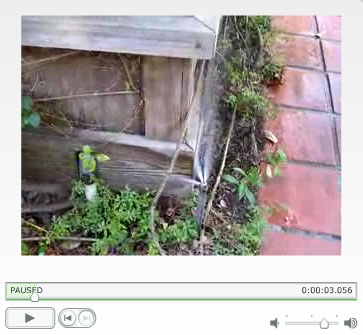
Italgreen- An Environmental Option for Synthetic Turf
With the increasing options available with synthetic turf, and the environmental benefits of not requiring watering, mowing, or fertilization, more people are considering synthetic turf alternatives. Italgreen is product now being carried locally that combines the benefits of removing natural turf, with an environmental material construction. Many of the current synthetic turfs combine various types of plastics to simulate a natural grass blade. There are some environmental concerns (most specifically with lead- see this Chronicle Story) with the long term effects of leaching or runoff from these products.
The manufacturer touts a number of benefits to their product. This type of turf has is constructed of a more environmentally friendly yarn construction, instead of plastic based blades. It also uses an organic granule infill instead of recycled rubber infill pellets. The results are a non toxic material, with better heat absorbtion and a softer feel.
Preparing Your Garden for Drought
Click here for an easy to read .pdf version of this article
Water agencies across California are bracing for a drought year, and either preparing or have already implemented water restrictions. As resources become more and more limited water districts are going to require more mandatory water savings measures. Landscape lawns and plants can be a major water user, but there are some simple steps you can take to make your garden more water efficient.
Take a look at your irrigation controller:
For many people their landscape controller goes untouched in a back corner of the garage, or is the exclusive domain of their gardener. Basic controller operation is easy; take some time to walk through your controller programming and basic functions. Most controllers have .pdf versions of their manuals online. Your controller needs to be adjusted seasonally based on temperature, rainfall and the water needs of your plants. While this can intimidating at first, once you get the hang of the water usage patterns for your garden, it is easy to make adjustments.
In Marin, MMWD has recommendations online for the amount to water plantings and lawns that is updated each week based on weather conditions. Use this as a starting point, and then make adjustments either up or down based on observation and the needs of your garden. For dormant periods in the winter and early spring for example, MMWD recommends not watering plants unless they shown signs of wilting.
There are also an increasing variety of technologically advanced sprinkler controllers that make automatic adjustments based on temperature, rainfall and humidity. Depending on the type, you can install a small localized weather station for your garden, or have data beamed directly to your controller. You can find an outstanding overview on Smart Controllers from the San Francisco Chronicle.
Upgrade Your Sprinkler System
1. Rain Sensors- If you don’t already have a rain sensor, these are devices that will automatically shut off watering when rainfall reaches a certain point such as 1/8″ or 1/4″. They are an easy way to manage watering during the rainy season without running to shut off your controller.
2. High Efficiency Irrigation- Converting existing planting beds from spray heads to drip irrigation can result in major water savings. Take this example, a water audit we performed for a client with a planting bed with 15 spray heads:
-Existing: 15 spray heads, average output per head 2.5 gallons per minute each
-Proposed: Replace with 45 drip emitters, average output per emitter .016 gallons per minute each
-Monthly Estimated Savings:Assume watering 3 times per week for 10 minutes (30 minutes per week, 130 minutes per month)
Existing sprinkler consumption: 4,875 gallons
New drip consumption: 97.5 gallons
While this is a simplified example, (the drip system may require a longer watering time per week) it goes to show how you can improve your watering efficiency dramatically by switching to a drip system with lower evaporation, lower output, and lower waste.
3. Next Generation sprayheads- For areas where drip irrigation isn’t a good fit, there is an array of new higher efficiency lower output sprinkler spray heads and rotors that are up to 50% more efficient than older models.
Xeriscape
Reducing your water consumption by eliminating high water use plants and lawns is an extremely effective way to curb water use. There are a variety of alternative lawn materials, and drought friendly plants that can help accomplish this. In addition to bold measures like tearing out your lawn, simple steps like adding bark or gravel mulch can help reduce evaporation and make the water that is applied to plants more effective. Read here our articles on alternative lawns, synthetic lawns, and view MMWD’s Water Wise Plant List.
Making these changes frequently require some effort and cost. But the work is rewarded by a more environmentally friendly garden, one that can better survive a drought. Given current weather patterns and strains on the water supply, making these changes now can better prepare your garden and home for water restrictions in the future.
For More Information:
Reference Manuals Online for Common Controller Types:
-Irritrol
-Toro
-Rain Bird
-Hunter
-Orbit
-Check out MMWD’s 10 Easy Ways to Conserve Water
–The Bay Friendly Landscape Program has an wealth of best practices information for saving water and reducing environmental impacts of your garden.
Green Building Products- Green Fusion Design Center
A good source for ecologically friendly building products is Green Fusion Design Center in San Anselmo. Green Fusion’s mission is, as described on their website: “to promote the understanding and use of green building practices by connecting homeowners, design professionals, builders and the general public with natural, eco-friendly, healthy products and services. The company is committed to the process of inspiring our culture toward conscious lifestyle practices by providing modern goods that blend function, style and sustainability.”
To that end, their showroom provides a variety of home improvement and building products, many of which are highlighted in their products section of the website.
Products include paints, stains, ecologically sustainable wood products, recycled materials, and furnishings.
For More:
AFM Safecoat– Non Toxic Paints and Stains
Anna Sova– organic paints and textiles
Greenhome
Buildinggreen.com
Oikos Green Building Directory
A Good Deer Repellent
We got a recommendation for an organic deer repellent for plants from a client recently. Plantskydd, developed in Sweden, is a non-toxic blend of blood meal and vegetable oils. Supposedly the material last 4-6 months after application, although we have not tried it on a project yet. The spray deters deer, rabbits, and elk from eating garden plants or vegetables.
Yet another weapon in the fight to protect plants against deer.
Alternatives to Lawns
The lawn is archetypal to the American landscape, it is one of the elements central to the planning of most residential gardens and commercial landscapes. According to the Sierra Club, Americans spend 8.4 billion a year on their lawns. This reflects how the lawn is one of the most maintenance intensive portions of any landscape- with mowing, watering, fertilization, weed control, aeration and dethatching required to keep a lawn looking its best.
Yet, despite all the maintenance and cost we still love our lawns. Typically lawns are desired for two reasons. Principally, lawns create a wonderful aesthetic. The lush green manicured appearance fits well with a number of design styles. The lawn’s low uniform appearance also creates an illusion of space. And, despite the maintenance requirements, lawn maintenance is a sector of gardening much catered to, with mowers, fertilizers and training (kids mowing lawns on Saturdays growing up). The lawn if properly cared for is often easier to keep look pristine than some lawn alternatives.
Some designers and environmentalists espouse removing the lawn from landscapes, replacing it either with groundcovers that grow in a similar habit to a lawn, general groundcover plants, or with a meadow of taller grasses.
There are a couple of ways of considering alternative lawns. From an environmental standpoint, while using lawn alternatives on a residential scale would have some beneficial effect on water use and fertilizer and pesticide runoff, especially if aggregated on a large scale. However, a residential project here and there is not going to have a large effect. The commercial sector is where lawn alternatives make the most sense. Typically large tracts of lawn in apartment complexes, office parks and other commercial settings serve little functional purpose other than providing a familiar aesthetic. These landscapes also typically incorporate thousands of square feet of lawn, compared to the typical residential lawn of 500-1500 square feet.
So should a homeowner consider lawn alternatives for their residential project? It depends on what the lawn is used for and its place in the design and the environment where the lawn is installed. If the kids play football in the backyard a lawn is hard to beat. But if the lawn is just filling space of a traditional design aesthetic, there are alternatives worth considering. In arid areas, alternatives start to make more sense. The new Wynn Casino in Las Vegas for example, installed synthetic turf instead of traditional lawn.
For more on these alternatives visit the following sites that outline other types of plantings that can take the place of the lawn:
Sierra Club- Alternative Lawns
Clover Alternatives to Lawn Grass
Eartheasy Lawn Alternatives– Includes many groundcovers
Lesslawn.com– The name says it
Organic Lawn Management- From Wikipedia
Alternatives from Oregon State University
Wildflower Alternatives
SynLawn- Synthetic Lawn Alternatives
A Natural Repellant for Gophers
Gophers can be a vexing garden problem with many different solutions. A range of products exist including traps, poison, sonic deterrents, plant protection cages, etc. One product recently mentioned by a colleague that works as an organic, non lethal deterrent is a caster-oil based mixture that is sprayed in the affected area and is supposed to deter gophers. This is another option to consider when countering these subterranean pests.
One spray called Gopher-Mole Med, is supposed to last for up to two months per application.

Image from Wikipedia

